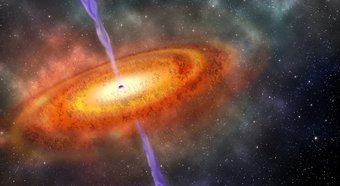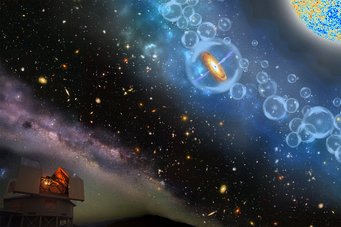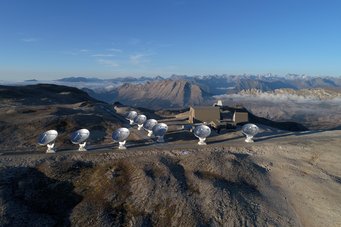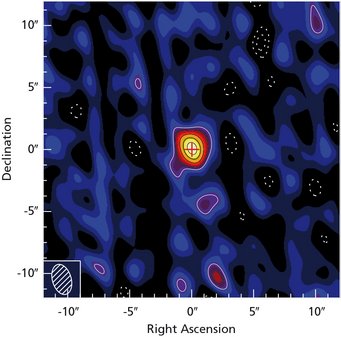The most distant black hole in the cosmos: quasar at a distance of 13 billion light-years discovered
Astronomers have discovered the most distant quasar known, which is so far from us that its light has taken more than 13 billion years to reach us. We see this quasar as it was a mere 690 million years after the Big Bang, and its light carries valuable information about the early history of the universe, in particular the reionization phase. At the center of the quasar is a massive black hole with a mass of almost 1 billion solar masses. In addition, the quasar's host galaxy has been found to contain a large amount of gas and dust, challenging models of galactic evolution. The results have now been published in Nature and in the Astrophysical Journal Letters.
| Background information | Download area | In-depth description of the results |

Künstlerische Darstellung eines Quasars: ein supermassereiches Schwarzes Loch, umgeben von einer Akkretionsscheibe aus heißer Materie. Astronomen haben den fernsten bisher bekannten Quasar gefunden und die Beobachtungsdaten genutzt, um Informationen über das frühe Universum zu erhalten.
Astronomers have discovered the most distant known black hole: a so-called quasar whose light has taken 13 billion years to reach us. In consequence, the light shows that quasar as it was 13 billion years ago, a mere 690 million years after the Big Bang.
The discovery was part of a concerted, multi-year search for ever more distant quasars led by Fabian Walter and Bram Venemans of the Max Planck Institute for Astronomy. It was made by Eduardo Bañados, of the Carnegie Institution for Science, using the institution's 6.5 meter Magellan telescopes in Chile, and made use of astronomical survey data such as that NASA's WISE infrared space telescope.
Quasars are powered by supermassive black holes in the centers of galaxies – in this case, a black hole with almost a billion times the mass of the Sun. Matter such as gas falling onto the black hole will form an ultra-hot accretion disk before falling in, making the whole setup one of the most luminous objects in the universe: a quasar. The newly discovered quasar shines as brightly as 40 trillion suns.
Distant quasars are valuable sources of information about the early universe. For one, they can be used to "X-ray" the universe over large distances. Quasar light can be decoded to yield information about the hydrogen atoms the light has encountered along its billion-light-year-journey. The light of the newly discovered most distant quasar yet carries crucial information regarding one of the earliest phases of the universe, the so-called reionization phase.

Schematische Darstellung jenes Blicks in die kosmische Geschichte, den die Entdeckung des fernsten bisher bekannten Quasars ermöglicht. Die Beobachtung mit einem der Magellan-Teleskope (unten links) erlaubt es uns, Informationen über die so genannte Reionisierungsepoche ("Blasen" oben rechts) zu gewinnen, die auf die Urknallphase folgte (oben rechts).
About 380,000 years after the Big Bang, the universe had cooled down sufficiently to form hydrogen atoms. Some hundreds of millions of years later, the energetic ultraviolet radiation of the first stars and the accretion disks of the first black holes reionized nearly all of the hydrogen in the universe, separating the electrons from the hydrogen nuclei (protons). The timing and specifics of this cosmic reionization are still an open question. Eduardo Bañados, lead author of the article describing the discovery, says: "Reionization was the universe’s last major transition, and it is one of the current frontiers in astrophysics."
The newly discovered quasar adds a crucial data point: Its light shows that a significant fraction of hydrogen was still neutral 690 million years after the Big Bang. This favours models which predict that reionization happened comparatively late in the history of the universe.
Quasars as young as this one also yield valuable information about galaxy evolution. For instance, at almost a billion solar masses, the quasar's central black hole is comparatively massive. Explaining how such a massive black hole could have formed in such a comparatively short amount of available time is a challenge for models of supermassive black hole formation, and effectively rules out some of those models. Bañados says: "Gathering all this mass in fewer than 690 million years is an enormous challenge for theories of supermassive black hole growth."
In an effort led by MPIA's Bram Venemans, the astronomers targeted the quasar with the millimeter telescope NOEMA, operated by IRAM, in the French Alps and the VLA radio telescope array in Socorro, New Mexico. With those observations, the astronomers were able to identify and examine the quasar's host galaxy. Although the galaxy can be no more than 690 million years old, it has already formed an enormous amount of dust, and heavy chemical elements. This means it must already have formed a large amount of stars. Again, this is a challenge for models, this time for models of galaxy evolution. Bram Venemans says: "Models of galaxy evolution will need to be able to explain how a galaxy could form the stars needed to produce the observed amounts of dust and heavier chemical elements in such a comparatively short time."
Reionization, black hole evolution, galaxy evolution – even with these first observations, the newly discovered quasar has given astronomers key information about cosmic history. Follow-up observations, as well as a search for similar quasars, are on track to put our picture of early cosmic history onto a solid footing.
Background information
The results described here were published as Bañados et al., "An 800 million solar mass black hole in a significantly neutral universe at redshift 7.5" in the journal Nature, and as Venemans et al., "Copious amounts of dust and gas in a z=7.5 quasar host galaxy" in the Astrophysical Journal Letters.
An in-depth description of the results can be found here.
Advanced access to the Nature article can be obtained via press@nature.com
Once published, the ApJ article will be available at this link.
- Press release by the Carnegie Institution for Science
- JPL press release
- MIT press release
- IRAM press release
The MPIA researchers involved were Bram P. Venemans, Chiara Mazzucchelli, Emanuele P. Farina, Fabian Walter, Roberto Decarli and Hans-Walter Rix
in collaboration with
Eduardo Bañados (Carnegie Institution for Science), Xiaohui Fan (University of Arizona), Chris Carilli (NRAO and Cavendish Laboratory, Cambridge, UK), Feige Wang (Peking University), Joseph Hennawi (University of California, Santa Barbara), Rob Simcoe (MIT) and others.
Additional figures and download

Figure 1

Figure 2

Figure 3




